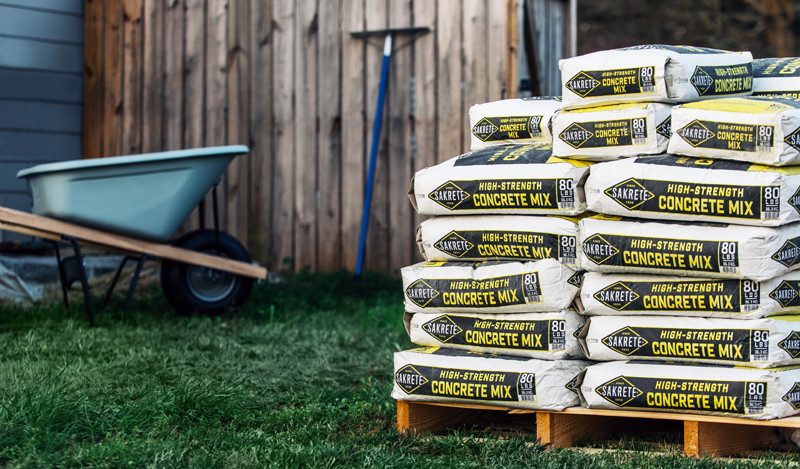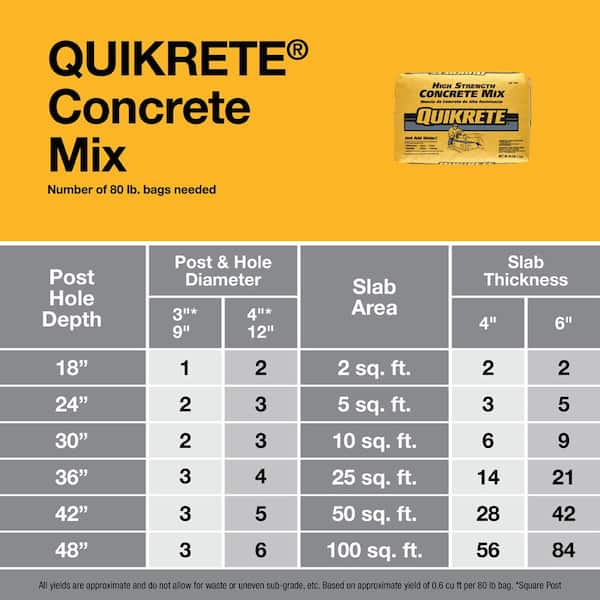A pallet typically holds 42 bags of concrete. This quantity may vary based on bag size.
Are you planning a construction project and wondering how many bags of concrete come on a pallet? Understanding the number of bags of concrete on a pallet is crucial for estimating your project needs accurately. Whether you are a contractor or a DIY enthusiast, having this information can help you plan and budget effectively.
In this blog post, we will delve into the details of how many bags of concrete you can expect to find on a standard pallet. Let’s explore the factors that determine the quantity of concrete bags on a pallet and why this information is essential for your construction endeavors.
Introduction To Concrete Packaging
Concrete packaging typically involves bags of cement that are stacked on pallets for storage and transportation. The number of bags per pallet can vary depending on the size and weight of the bags, but typically ranges from 40 to 80 bags per pallet.
Concrete packaging refers to the different methods and materials used to store and transport concrete products. It plays a crucial role in ensuring the quality, safety, and efficiency of concrete distribution. Understanding the various packaging types and their benefits is essential for construction professionals and DIY enthusiasts alike.
Common Packaging Types
Concrete is commonly packaged in bags, bulk, and on pallets. Bagged concrete typically comes in 40, 60, or 80-pound bags, allowing for easy handling and mixing. Bulk concrete is transported in specialized vehicles and poured directly at the construction site. Palletized concrete, on the other hand, involves stacking multiple bags of concrete on a pallet for convenient storage and transport.
Benefits Of Palletized Concrete
- Efficient handling and storage
- Reduced risk of damage during transport
- Enhanced organization at construction sites
- Minimized manual labor for loading and unloading

Credit: www.sakrete.com
Standard Pallet Sizes And Capacities
Dimensions Of A Typical Pallet
The dimensions of a standard pallet are 48 inches by 40 inches.
Weight Limits For Safe Handling
It’s crucial to adhere to weight limits for safe handling. A standard pallet has a maximum weight capacity of 4,600 pounds.
Concrete Bag Sizes
Discover the convenience of concrete bag sizes on a pallet. Each pallet typically holds around 40 to 60 bags, depending on the size and weight of the concrete bags. This makes transportation and storage of concrete more efficient for your projects.
Calculating Pallet Load
Calculating pallet load is crucial to ensure safe transportation and delivery of goods. When it comes to bags of concrete on a pallet, the number will depend on the size and weight of the bags, as well as the pallet’s weight capacity.
Estimating Number Of Bags Per Pallet
When calculating bags per pallet, consider bag size and pallet dimensions.
- Determine bag size and weight.
- Measure pallet length, width, and height.
- Divide pallet volume by bag volume.
Understanding Load Distribution
Load distribution ensures pallet stability and safe transportation.
- Place heavier bags at the bottom.
- Stack bags uniformly for balanced weight distribution.
- Secure the load with straps or shrink wrap.
Factors Affecting Pallet Configuration
The number of bags of concrete on a pallet can vary depending on the size and weight of the bags. Factors affecting pallet configuration include bag dimensions, weight restrictions, and pallet size. It’s important to consider these factors to ensure safe and efficient pallet configuration for concrete bags.
Manufacturer Specifications
The number of bags of concrete on a pallet varies depending on the manufacturer’s specifications. While some manufacturers package 60-pound bags in batches of 40, others package 80-pound bags in batches of 30. It is important to check the specifications provided by the manufacturer to determine the number of bags on a pallet. This will help you to calculate the amount of concrete required for your project accurately.Transportation And Storage Considerations
Transportation and storage are significant factors that affect the pallet configuration. The pallets must be designed in such a way as to ensure that they can be loaded onto a truck and transported without any damage. Additionally, they must be stored in a way that ensures that they are not exposed to the elements, which can cause moisture damage and reduce the quality of the concrete. The pallet configuration must be designed with these considerations in mind to ensure that the concrete is delivered to the customer in good condition. In conclusion, the number of bags of concrete on a pallet depends on the manufacturer’s specifications and transportation and storage considerations. It is important to consider these factors when designing the pallet configuration to ensure that the concrete is delivered to the customer in good condition.Purchasing Tips For Concrete Bags
A pallet of concrete bags typically contains 42 to 63 bags, depending on the size and weight of each bag. When purchasing concrete bags, consider the amount of concrete needed for the project and the weight capacity of the pallet to ensure a sufficient supply without exceeding the load limit.
Bulk Buying Advantages
Buying concrete bags in bulk offers cost savings.
Buying in bulk reduces overall project expenses.
Planning ahead allows for bulk purchasing benefits.
Negotiating With Suppliers
Discuss discounts for large volume purchases.
Ensure quality and delivery terms are clear.
Communicate project deadlines for timely delivery.
Loading And Unloading Pallets Safely
When it comes to loading and unloading pallets, safety should always be the top priority. Proper handling of equipment and following safety protocols can help prevent accidents and ensure a secure working environment. In this section, we will discuss the equipment needed for efficient handling as well as the safety protocols that should be followed.
Equipment For Efficient Handling
Efficient handling of pallets requires the right equipment to ensure smooth operations. Here are some essential tools:
- Forklift: A forklift is a versatile and powerful machine that is commonly used for lifting and moving heavy loads on pallets. It is equipped with forks that can easily slide under the pallets, allowing for efficient loading and unloading.
- Pallet Jack: A pallet jack, also known as a pallet truck, is a manual tool used to lift and transport pallets. It is ideal for smaller loads and narrow spaces where a forklift may not be suitable.
- Straps and Tie-Downs: These are essential for securing the pallets to prevent them from shifting or falling during transportation. Using strong and reliable straps and tie-downs ensures the stability of the load.
Safety Protocols To Prevent Accidents
Adhering to safety protocols is crucial to prevent accidents and injuries during the loading and unloading process. Here are some important safety measures to follow:
- Wear Protective Gear: Always wear proper protective gear, such as safety shoes, gloves, and a hard hat, to protect yourself from potential hazards.
- Inspect Pallets: Before loading or unloading, inspect the pallets for any damage or defects. Weak or damaged pallets should be replaced to ensure the stability of the load.
- Secure the Area: Make sure the loading and unloading area is clear of any obstacles or debris that may cause accidents. Clearly mark the area to alert others of ongoing operations.
- Follow Weight Limits: Ensure that the weight of the load does not exceed the weight limit specified for the pallet or the equipment being used. Overloading can lead to instability and accidents.
- Proper Lifting Techniques: Use proper lifting techniques to avoid strains and injuries. Bend your knees, keep your back straight, and lift with your legs rather than your back.
- Communicate and Coordinate: If working as a team, clear communication and coordination are essential. Establish hand signals or use radios to communicate effectively during the loading and unloading process.
- Be Mindful of Surroundings: Pay attention to your surroundings and watch for any potential hazards, such as uneven surfaces or overhead obstacles, that may pose a risk during the handling process.
By following these safety protocols and using the right equipment, you can ensure a safe and efficient loading and unloading process, minimizing the risk of accidents and creating a secure working environment.

Credit: www.homedepot.com
Storage And Shelf Life Of Palletized Concrete
Palletized concrete is a popular choice for construction projects due to its convenience and ease of use. However, it is important to understand the storage and shelf life of palletized concrete to ensure its optimal usability. By following proper storage guidelines, you can maximize the lifespan of your concrete bags and maintain their quality for longer periods.
Optimal Storage Conditions
To keep your palletized concrete in the best possible condition, it is crucial to store it under optimal conditions. Here are some key factors to consider:
- Temperature: Store the concrete bags in a cool and dry environment, away from direct sunlight and extreme temperatures. Fluctuations in temperature can affect the quality and consistency of the concrete.
- Humidity: Keep the storage area dry and free from excessive moisture. High humidity can lead to the formation of clumps or lumps in the concrete, making it difficult to use.
- Ventilation: Ensure proper ventilation in the storage area to prevent the accumulation of moisture and the growth of mold or mildew. Good airflow will help maintain the integrity of the concrete bags.
- Protection: Shield the concrete bags from any potential damage caused by water, dust, or debris. Covering them with a tarp or placing them on pallets can provide an extra layer of protection.
Maximizing The Usability Of Concrete Bags
By following these guidelines, you can extend the shelf life of your palletized concrete, ensuring that each bag remains usable for longer:
- First-in, first-out: Practice proper inventory management by using the oldest bags first. This rotation system prevents bags from sitting in storage for too long, reducing the risk of deterioration.
- Regular inspections: Periodically check the condition of the bags for any signs of damage, such as tears or punctures. Damaged bags should be used first to prevent further degradation.
- Proper handling: Avoid rough handling of the bags, as it can lead to the formation of clumps or breakage. Gently stack and organize the bags to maintain their integrity.
- Adherence to expiry dates: Concrete bags have an expiration date printed on them. It is crucial to use them before the specified date to ensure optimal performance and avoid any potential issues.
By implementing these storage and handling practices, you can make the most out of your palletized concrete, ensuring its usability and quality for your construction projects.
Common Faqs About Concrete Pallets
Concrete pallets typically hold around 63 bags of concrete. This quantity may vary based on the size and weight of the bags. It’s important to consider the pallet’s load capacity and the specific requirements of your project when determining how many bags of concrete can be safely accommodated.
Addressing Common Concerns
Concrete pallets typically hold 42 to 63 bags of concrete. Each bag weighs 40 to 80 pounds.Expert Tips For Concrete Use And Storage
Proper storage helps maintain concrete quality. Keep bags off the ground and away from moisture. – Store bags in a cool, dry place away from direct sunlight. – Avoid stacking bags more than five high to prevent damage. – Use concrete within 90 days for best results. Inspect bags for any tears or damage before use. Mix concrete thoroughly for best performance.| Bag Weight | Number of Bags on Pallet |
|---|---|
| 40 lbs | 63 bags |
| 60 lbs | 42 bags |
| 80 lbs | 42 bags |

Credit: patch.com
Frequently Asked Questions
How Many Bags Of Concrete Are On A Pallet?
A standard pallet can hold 56 bags of concrete. The quantity may vary depending on the size and weight of the bags. Always check the manufacturer’s guidelines for specific information.
What Is The Weight Of A Bag Of Concrete?
A typical bag of concrete weighs around 80 pounds. However, some bags may weigh slightly more or less, so it’s important to verify the weight of the specific bags being used.
How Much Concrete Does A Bag Yield?
A 80-pound bag of concrete yields approximately 0. 6 cubic feet when mixed with water. This yield may vary slightly based on the consistency of the mix and the specific product used.
What Are The Dimensions Of A Bag Of Concrete?
Standard dimensions for a bag of concrete are approximately 12 inches in width, 4 inches in depth, and 24 inches in height. However, these dimensions can vary based on the manufacturer and type of concrete.
Conclusion
To conclude, determining the number of bags of concrete on a pallet is crucial for any construction project. By understanding the weight and size of each bag, as well as the dimensions of the pallet, you can effectively plan and budget for your concrete needs.
Whether you are a homeowner or a professional contractor, this knowledge will ensure a successful and efficient concrete installation. Remember to always consult with your supplier for accurate information. Happy building!
